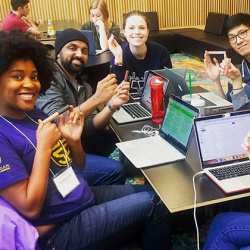From Theory to Practice: How Students Are Using AI at Michigan Ross

The University of Michigan is at the forefront of generative artificial intelligence adoption in higher education — it was the first major university in the world to create its own AI tools. Here’s how the Ross School of Business utilizes AI and what resources it offers students.
AI courses and research
Since generative AI hit the mainstream in 2022 with the release of ChatGPT, artificial intelligence, particularly in the form of large language models, has been transforming industries at a rapid pace. In the business world, companies are beginning to move beyond experimentation and integrating AI into real-world operations. As adoption continues to accelerate, it’s crucial for today’s business leaders to understand how to harness AI effectively.
At Michigan Ross, work is already underway to prepare students to step into their future roles with AI fluency. Multiple classes revolve around the use of AI in business, including:
- Empowering Business Decision-Making with Generative AI (TO 538)
- Artificial Intelligence for Business (TO 433 and 633)
- Executive Primer on Generative AI (EMBA 701)
- Artificial Intelligence and Machine Learning in Investment Strategies (FIN 427)
- Collective Intelligence (MO 410)
In addition to these dedicated classes, numerous other courses address AI in different contexts. For example, in Legal Knowledge for Values-Driven Leaders (BL 536), taught by Norman Bishara, professor of business law and ethics, students examine “the future of work and a just transition with artificial intelligence and automation” alongside their explorations of cross-national business ethics, frameworks used to assess a company's sustainability and ethical impacts, and more.
Faculty thought leaders continue to contribute to the global conversation about AI’s impacts through research, such as Professor of Strategy Felipe Csaszar’s examination of AI's impact on strategic decision-making processes and Assistant Professor of Technology and Operations Sam Keppler’s research on the use of AI in K-12 education.
Using AI in the classroom
In addition to discovering more about AI’s capabilities in the business world, students also use AI tools to assist with learning in and outside the classroom. Some are even part of a collaboration with Google Public Sector to pilot new AI teaching assistant technology.
To find out more about how current students are learning about and utilizing AI, we asked one MBA and one BBA student to tell us about their experience with AI at Ross.
 Chloe Bally, MBA ’25
Chloe Bally, MBA ’25
What is your post-graduation career goal?
I want to use my dual expertise in AI research and business to build great products at the forefront of innovation. I could work in big tech as a project manager alongside researchers and engineers or in a fast-growing, research-backed startup that I help push to the next level.
In what ways have you found AI integrated into your learning experience at Michigan Ross?
Andrew Wu, associate professor of technology and operations, was already teaching genAI classes in early 2024, which made us early experts. The Business+Tech GenAI conference was also an amazing opportunity to apply GenAI in a use case with their GenAI Case Competition.
AI is not just GenAI. Ross has faculty experts who teach machine learning algorithms and data analytics, from descriptive to prescriptive. In our assignments, we had to create our own prediction models using R, Python, etc., which is incredibly useful when communicating with researchers and data scientists.
We’ve also learned how to compare models and what metrics to look at, which is essential as it helps me understand and assess cheaper alternatives without the cost of quality.
Looking outside Ross, many similar initiatives confirm U-M’s stance in pioneering AI. Ravi Pendse, U-M vice president for information technology and chief information officer, is leading the way.
What’s one of the most surprising or eye-opening things you’ve learned about AI in a business context?
Just like power is an amplifier of impact (good or bad), AI is a skill amplifier. If you teach it well, AI can pretty much do anything. The business game is being reshuffled.
It's eye opening that despite all the changes around and because of AI, the underlying truths stay true. You need hard work, good values, and respect for people to do business. There will be a lot of noise, but those who come up stronger and rise above the crowd will be the hard workers who use AI to amplify themselves rather than those who use AI to do work for them.
I’ve been tempted both to use AI to replace my critical thinking and to use AI as support to enhance my critical thinking. The first can get me from A to B, but the second gives me wings.
Have you faced any challenges in understanding or applying AI concepts? How did you overcome them?
Reinforcement learning and layering/memory. I went to engineering schools, attended conferences, and started projects with researchers to understand it from the source. Be curious. Ask ‘dumb’ questions. Learn with a beginner's mind. Go meet experts in the field.
 Arnav Nikam, BBA/BSE ’27
Arnav Nikam, BBA/BSE ’27
What is your post-graduation career goal?
I plan to work in product management in finance/technology.
In what ways have you found AI integrated into your learning experience at Michigan Ross?
At Ross, I’ve leveraged U-M’s Maizey AI by training it on my Ross course materials (e.g., lecture slides and case studies) to create a personalized study assistant. For example, I input lecture content to generate sessions and clarify complex models. Beyond Maizey, I’ve used other AI tools and features to auto-generate study guides, practice exams, and flashcards from my notes, streamlining exam prep.
What’s one of the most surprising or eye-opening things you’ve learned about AI in a business context?
I was surprised by how Unilever uses AI and sentiment analysis to analyze thousands of customer calls and social media interactions, identifying pain points in real time to improve service strategies. This not only boosts customer satisfaction by 20% but also reduces training costs by automating feedback loops. It reshaped my view of AI as a tool for empathy-driven decision-making, not just efficiency.
Can you describe a real-world example of AI in business that resonated with you?
From my past experiences with e-commerce, I have two examples that resonated with me. Walmart’s dynamic pricing strategy utilizes AI to adapt to the consumer. By analyzing competitor prices, demand trends, and inventory levels, Walmart adjusts prices in real time to stay competitive. This approach has improved profit margins by 3-5% and optimized stock turnover. Lastly, eBay’s AI-driven image search allows users to upload photos to find similar products, streamlining discovery. This feature improved search-to-purchase conversion rates by 28% compared to traditional text-based searches
Have you worked on any hands-on projects involving AI? If so, what did you learn from that experience?
For a hackathon on campus, my friends and I created an app to help visually impaired and blind people. We utilized AI to analyze and describe the person’s environment in real-time, just based on the camera in their phone. This project opened my eyes to how AI is, can, and will be integrated into improving the day-to-day lives of all of us.







